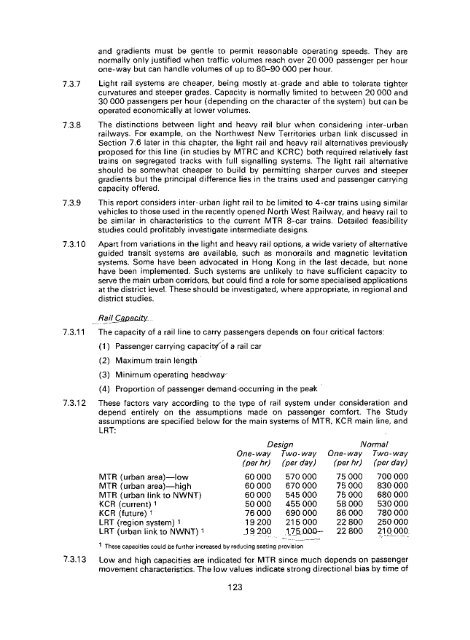Untitled - HKU Libraries - The University of Hong Kong
Untitled - HKU Libraries - The University of Hong Kong
Untitled - HKU Libraries - The University of Hong Kong
- No tags were found...
You also want an ePaper? Increase the reach of your titles
YUMPU automatically turns print PDFs into web optimized ePapers that Google loves.
and gradients must be gentle to permit reasonable operating speeds. <strong>The</strong>y arenormally only justified when traffic volumes reach over 20 000 passenger per hourone-way but can handle volumes <strong>of</strong> up to 80-90 000 per hour.7.3.7 Light rail systems are cheaper, being mostly at-grade and able to tolerate tightercurvatures and steeper grades. Capacity is normally limited to between 20 000 and30 000 passengers per hour (depending on the character <strong>of</strong> the system) but can beoperated economically at lower volumes.7.3.8 <strong>The</strong> distinctions between light and heavy rail blur when considering inter-urbanrailways. For example, on the Northwest New Territories urban link discussed inSection 7.6 later in this chapter, the light rail and heavy rail alternatives previouslyproposed for this line (in studies by MTRC and KCRC) both required relatively fasttrains on segregated tracks with full signalling systems. <strong>The</strong> light rail alternativeshould be somewhat cheaper to build by permitting sharper curves and steepergradients but the principal difference lies in the trains used and passenger carryingcapacity <strong>of</strong>fered.7.3.9 This report considers inter-urban light rail to be limited to 4-car trains using similarvehicles to those used in the recently opened North West Railway, and heavy rail tobe similar in characteristics to the current MTR 8-car trains. Detailed feasibilitystudies could pr<strong>of</strong>itably investigate intermediate designs.7.3.10 Apart from variations in the light and heavy rail options, a wide variety <strong>of</strong> alternativeguided transit systems are available, such as monorails and magnetic levitationsystems. Some have been advocated in <strong>Hong</strong> <strong>Kong</strong> in the last decade, but nonehave been implemented. Such systems are unlikely to have sufficient capacity toserve the main urban corridors, but could find a role for some specialised applicationsat the district level. <strong>The</strong>se should be investigated, where appropriate, in regional anddistrict studies.Rai/^Capsnity.7.3.11 <strong>The</strong> capacity <strong>of</strong> a rail line to carry passengers depends on four critical factors:(1) Passenger carrying capacit/<strong>of</strong> a rail car(2) Maximum train lengtjv'(3) Minimum operating headway"(4) Proportion <strong>of</strong> passenger demand-occurring in the peak7.3.12 <strong>The</strong>se factors vary according to the type <strong>of</strong> rail system under consideration anddepend entirely on the assumptions made on passenger comfort. <strong>The</strong> Studyassumptions are specified below for the main systems <strong>of</strong> MTR, KCR main line, andLRT:DesignNormalOne-way Two-way One-way Two-way(per hr) (per day) (per hr) (per day)MTR (urban area)—low 60 000 570 000 75 000 700 000MTR (urban area)—high 60 000 670 000 75 000 830 000MTR (urban link to NWNT) 60 000 545 000 75 000 680 000KCR (current) 1 50 000 455 000 58 000 530 000KCR (future) 1 76 000 690 000 86 000 780 000LRT (region system) 1 19200 215000 22800 250000LRT (urban link to NWNT) 1 1.9 200 175J300- 22 800 21QJMXX1 <strong>The</strong>se capacities could be further increased by reducing seating provision7.3.13 Low and high capacities are indicated for MTR since much depends on passengermovement characteristics, <strong>The</strong> low values indicate strong directional bias by time <strong>of</strong>123
















